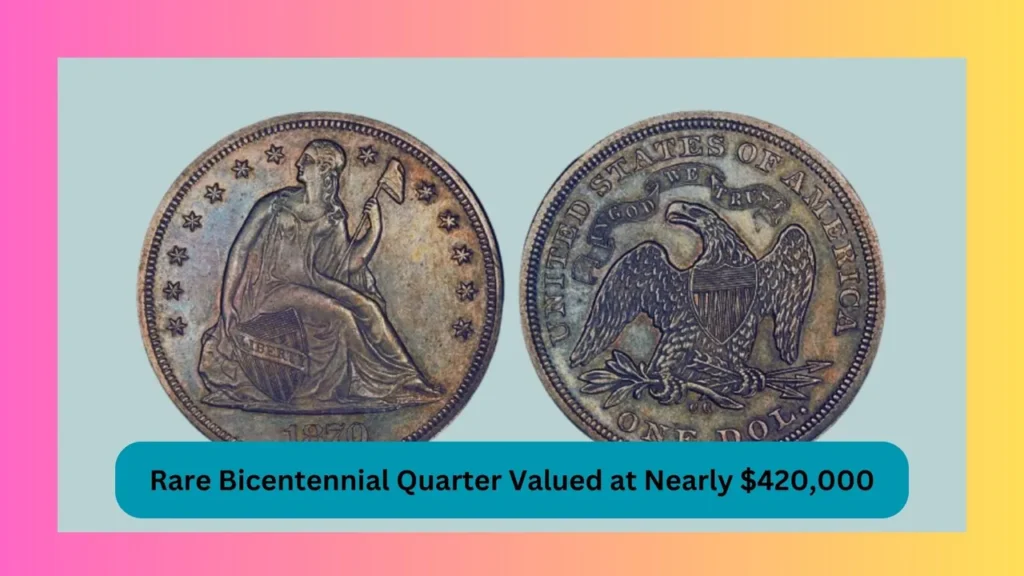Introduction
Imagine stumbling upon a simple quarter in your pocket change, only to find out it’s worth nearly $420,000! Sounds like a dream, right? Well, for some lucky collectors, this is a reality. The rare Bicentennial Quarter has become one of the most sought-after coins in the numismatic world. But what makes it so valuable? How can you tell if you have one? Let’s dive deep into the history, rarity, and value of this fascinating coin.

What Is the Bicentennial Quarter?
The Bicentennial Quarter was minted in 1975 and 1976 to commemorate the 200th anniversary of the United States’ independence. Unlike regular quarters, these coins feature a unique reverse design with a colonial drummer and a torch encircled by 13 stars, symbolizing the original 13 colonies. Instead of the usual date, these quarters are marked with 1776-1976.
Why Is the Bicentennial Quarter So Special?
Most Bicentennial Quarters are only worth their face value, but a select few are incredibly rare and valuable due to errors, special minting processes, or unique characteristics. Some of these quarters have fetched prices as high as $420,000!
The Factors That Make a Bicentennial Quarter Valuable
1. Mint Mark and Location
The mint mark on a quarter indicates where it was produced. The most common marks are:
- P (Philadelphia Mint)
- D (Denver Mint)
- S (San Francisco Mint – often proof coins)
The rarest and most valuable Bicentennial Quarters tend to come from special San Francisco Mint proofs or error coins from Philadelphia and Denver.
2. Metal Composition
Most Bicentennial Quarters are made of clad copper-nickel, but a small number were minted in 40% silver. These silver quarters, especially in uncirculated condition, are highly prized by collectors.
3. Error Coins
Coins with errors are incredibly rare and often command high prices. Some of the most valuable error types include:
- Double Die Errors – Design elements appear doubled.
- Off-Center Strikes – The coin’s image is not properly centered.
- Overstruck Coins – A second image appears faintly over the first.
- Wrong Planchet Errors – Struck on a different metal planchet than intended.
4. Condition and Grading
The condition of a coin plays a major role in its value. Coins are graded on a scale from Poor (P-1) to Perfect Mint State (MS-70). A Bicentennial Quarter graded MS-67 or higher can be worth thousands of dollars. Proof coins (PR-70) with deep cameo contrast are even more desirable.
The $420,000 Bicentennial Quarter – What Makes It Unique?
The Bicentennial Quarter that reached a staggering $420,000 at auction had all the right factors:
- Minted in silver
- Perfect MS-70 condition
- Struck with a rare error
- Only a few known to exist
Because of its rarity and demand among collectors, this particular coin became a once-in-a-lifetime find.
How to Identify a Rare Bicentennial Quarter
Step 1: Check the Date and Mint Mark
Look for 1776-1976 and check if it has a P, D, or S mint mark. Proof coins from San Francisco (S) are the most valuable.
Step 2: Examine the Edge
A silver Bicentennial Quarter will have a solid silver edge instead of a copper-colored stripe.
Step 3: Inspect for Errors
Use a magnifying glass to look for:
- Doubled lettering
- Misalignment or off-center design
- Unusual markings
Step 4: Get It Professionally Graded
If you suspect you have a valuable coin, send it to a professional coin grading service (PCGS or NGC) for verification and certification.
Where to Sell a Rare Bicentennial Quarter
If you find a rare Bicentennial Quarter, you have several options to sell it:
- Auction Houses – Ideal for high-value coins
- Online Marketplaces – eBay, Heritage Auctions, or Coin World
- Local Coin Dealers – Quick and hassle-free sales
- Coin Shows and Conventions – Connect with serious collectors
Other Rare and Valuable Quarters to Look For
While hunting for the rare Bicentennial Quarter, keep an eye out for other valuable quarters:
- 1932-D and 1932-S Washington Quarters (First year of Washington quarters)
- 1964 Silver Quarters (Last year of 90% silver quarters)
- 2004 Wisconsin Quarter with Extra Leaf Error (Valued at hundreds or thousands)
- 1955 Doubled Die Quarter (Highly sought after by collectors)
Final Thoughts – Could You Be Holding a Fortune?
So, do you have a rare Bicentennial Quarter hiding in your collection? If you do, it could be worth a life-changing amount! Even if yours isn’t the $420,000 jackpot, certain Bicentennial Quarters can still bring in hundreds or even thousands of dollars. Take a closer look at your change, and you might just strike gold—or, in this case, silver!
FAQs
1. How can I tell if my Bicentennial Quarter is silver?
Check the edge of the coin. If it’s solid silver, it’s a silver quarter. If you see a copper stripe, it’s a standard clad quarter.
2. Are all Bicentennial Quarters valuable?
No, most are worth only 25 cents. However, silver versions, error coins, and high-grade specimens can be worth hundreds or even thousands of dollars.
3. Where can I get my Bicentennial Quarter appraised?
You can take it to a coin dealer, grading service (PCGS or NGC), or numismatic expert for evaluation.
4. How much is a regular Bicentennial Quarter worth?
A circulated clad Bicentennial Quarter is typically worth face value (25 cents). An uncirculated or proof silver version can be worth $10-$20 or more.
5. What should I do if I think I have a rare Bicentennial Quarter?
First, research its features and check for errors or silver content. Then, have it professionally graded and consider selling it through an auction house or reputable dealer.
Now, go check your pocket change—you might just have a hidden treasure waiting to be discovered!